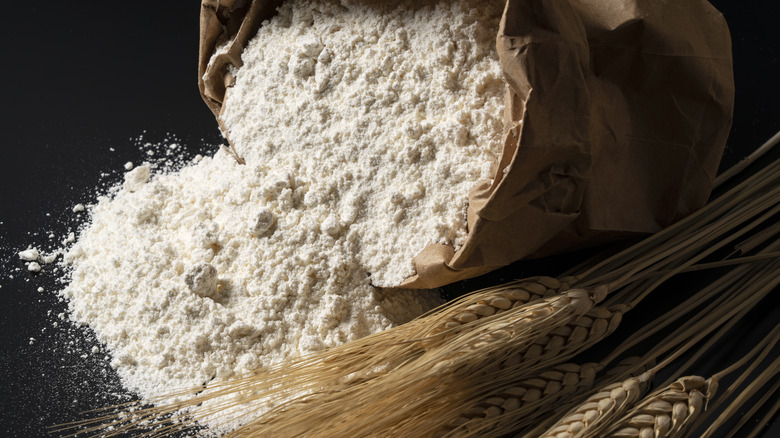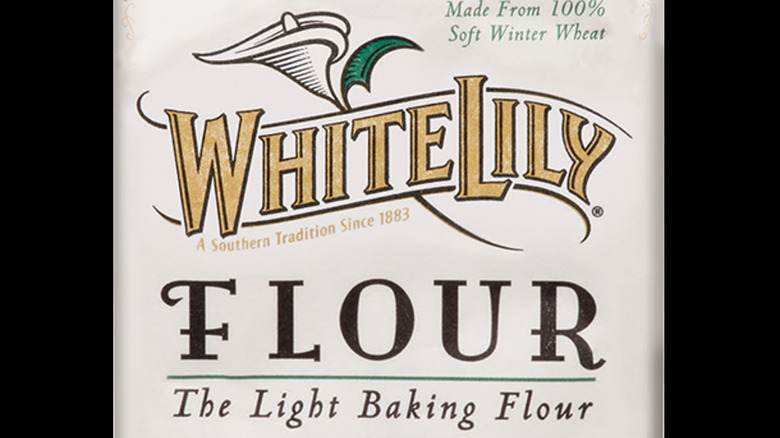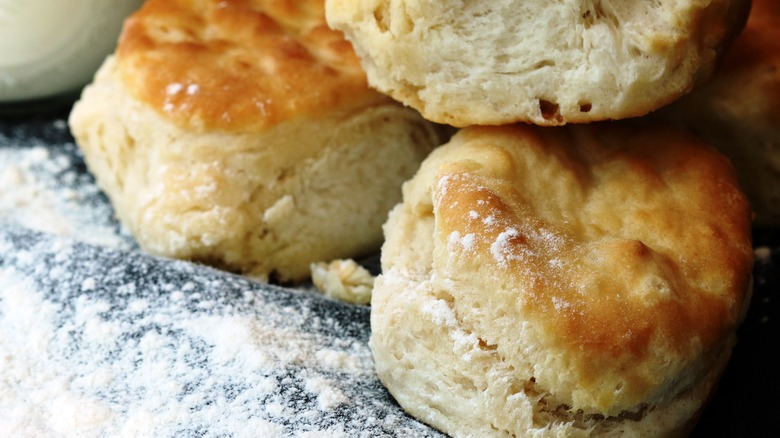Self-Rising Vs. Self-Raising Flour: The Composition Difference, Explained
You can get just about any type of flour these days: chickpea, almond, pea protein, millet, buckwheat, and many more. There's even gluten-free flour that is somehow still made of wheat. What?! If all of that's not dizzying enough, even if you limit your flour scope to one made from wheat, there are still seven types. And, each of those has variations from brand to brand. For example, the protein content of all-purpose flours can vary by a few percentage points, which is enough to affect the outcome of a recipe. You might end up with a cake full of tunnels, or tougher-than-usual biscuits.
Self-rising flour is unique because it includes additional ingredients: salt, for flavor; and baking powder, which provides the rise. According to Martha Stewart, it was developed for the British navy in the mid-19th century as a convenience for bakers at sea. As it became common for home cooks, it morphed into an entire industry of ready-to-use baking mixes, like Bisquick.
That all-in-one trio makes self-rising flour more convenient for the cook: less to measure and the ratio of leavener to flour was always correct. In some parts of the world, self-rising flour became flour. In the U.S. South, White Lily Self-Rising Flour is a pantry must-have that elicits strong feelings and memories of home cooking. For many, it's the key ingredient to legit Southern biscuits.
DIY self-rising flour
Aside from the nostalgia that White Lily flour might provoke, there's more to that bag of flour than a familiar label. This, and many other, self-rising flours are made with flour that's more like cake flour. The amount of protein in flour determines how much strength it has to provide some structure and chew. Bread flour has the highest percentage; cake flour has the lowest. In between, it is all-purpose. The same biscuits made with those three flours would be very different.
Bread flour is probably destined to become something leavened with yeast. Cakes, cookies, and biscuits are leavened with baking powder. So, it's the best starting point for self-rising flour. If you stumble onto a recipe calling for self-rising flour, it might be a good opportunity to grab some at the store. It's a handy thing to have around if you've run out of baking soda. Or, you can make your own.
America's Test Kitchen's self-rising flour substitute starts with cake flour. For every cup of cake flour, add 1½ teaspoons of baking powder, and ½ teaspoon of table salt. Mix this well and proceed with the recipe. If you don't have cake flour, you can pull two tablespoons of all-purpose flour from a cup, and add back two tablespoons of cornstarch.
That's a lot of substituting and clumsy kitchen math. Maybe the advantages of self-rising flour are becoming clear?
Self-rising vs. self-raising
As the cooking world shrinks and we have such easy access to recipes from around the world, there are some familiar translations that happen. For example, fresh coriander and chips in the U.K. are cilantro and fries in the U.S.
However, one U.K.-U.S. translation that seems obvious actually isn't. Assuming that self-raising flour is just an unfamiliar spelling of the same thing seems safe enough. However, there's a difference. According to Epicurious, self-raising flour probably doesn't include salt and the proportion of baking powder is upped to 2 teaspoons per cup of flour.
If you find yourself now converted to self-rising flour, don't mix up a massive batch of it. Baking powder's shelf life is shorter than flour. Flour stored at room temperature can last about one year, but baking powder, once opened, needs to be used within about six months. So, self-rising or self-raising flour should be used up quickly and has an expiration date you should definitely check before you make a cake. Or, just use those DIY ratios to make it up as you cook.


